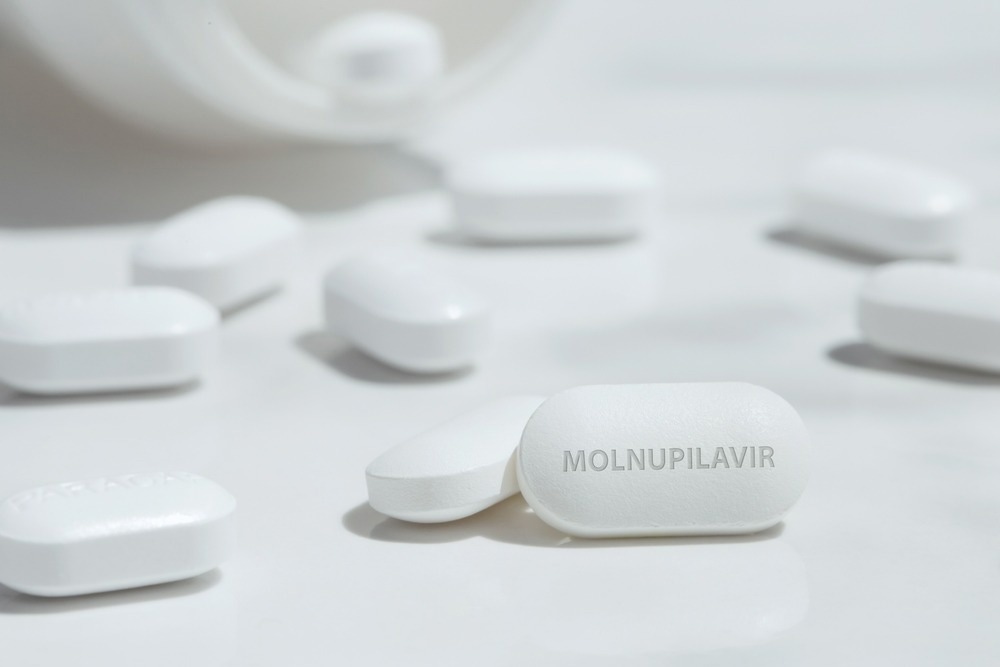In a recent study published in Nature, researchers discovered molnupiravir-associated mutational signature in severe acute respiratory syndrome coronavirus 2 (SARS-CoV-2) genomes.
 Study: A molnupiravir-associated mutational signature in global SARS-CoV-2 genomes. Image Credit: chayanuphol/Shutterstock.com
Study: A molnupiravir-associated mutational signature in global SARS-CoV-2 genomes. Image Credit: chayanuphol/Shutterstock.com
Background
Molnupiravir has been authorized in several countries to treat coronavirus disease 2019 (COVID-19). The drug is converted into molnupiravir triphosphate (a nucleoside analog) and incorporated into viral ribonucleic acid (RNA) strands, leading to sequence fidelity errors. This results in progeny that are not viable, thereby decreasing the effective growth rate of the virus.
The drug has been demonstrated to decrease viral load in animal models and COVID-19 patients. A large trial showed that molnupiravir treatment did not reduce hospitalizations or deaths in high-risk individuals. Further, recent trial findings and approval of more effective drugs have led to recommendations against the use of molnupiravir; meanwhile, concerns about the potential mutagenic activity in host cells have also emerged.
The study and findings
In the present study, researchers characterized the mutational profile of molnupiravir. They analyzed published genomic time series that included COVID-19 patients treated with molnupiravir and those who were not. Molnupiravir treatment caused an eight-fold increase in mutations, which was specific to transitions, especially guanine (G)-to-adenine (A) and cytosine (C)-to-thymine (T) mutations.
Increased G-to-A mutations were predictive of molnupiravir treatment since they are less frequent than C-to-T mutations in SARS-CoV-2 evolution. Next, the team analyzed a mutation-annotated tree containing over 15 million sequences from the Global Initiative on Sharing Avian Influenza Data (GISAID) and International Nucleotide Sequence Database Collaboration (INSDC) databases.
Filtering the tree to branches with ≥ 20 substitutions uncovered a region with elevated G-to-A mutations and almost exclusively transitions, which only had branches sampled in 2022 or later, suggesting some changes resulted in a new mutational pressure. These mutational classes were consistent with those in molnupiravir-treated patients.
Next, a criterion was developed to select branches with ten or more substitutions, of which 20% were C-to-U mutations, 25% were G-to-A mutations, and 90% were transitions. Nearly all branches meeting this “high G-to-A” criterion were sampled after molnupiravir was rolled out. Many countries with increased proportions of high G-to-A branches used molnupiravir. Countries with high sequencing but a low proportion of high G-to-A branches did not authorize molnupiravir.
Next, the team performed a mutational spectrum analysis. The spectrum for high G-to-A branches was dominated by transitions. When spectra were calculated from molnupiravir-treated patients and general SARS-CoV-2 evolution, a strong link was evident between the spectrum of high G-to-A branches and that of known molnupiravir sequences. Results were similar when the spectrum was calculated from a molnupiravir clinical trial dataset.
Although most long high G-to-A branches had one descendant sequence in databases, some branches yielded clusters with a substantial number of descendent sequences. One cluster identified in Australia in August 2022 had 20 descendent sequences and involved 25 substitutions in the main branch, all transitions. Its closely related outgroups were dated from July 2022, suggesting that mutations emerged over one or two months, which would have otherwise taken years at typical dynamics/rate of SARS-CoV-2 evolution.
High G-to-A branches also had different branch length distributions. For short branches, most mutations (65%) in the spike gene were non-synonymous. The proportion of non-synonymous spike mutations was 77% for long branches without the high G-to-A signature. On the other hand, for long branches with the high G-to-A signature, the proportion was 63%.
Non-synonymous spike mutations were concentrated in high G-to-A branches, even among the most recurrent mutations. Many recurrent mutations were those found in SARS-CoV-2 variants of concern. Finally, the association between molnupiravir use and high G-to-A branches was evaluated by linkage analysis of high G-to-A branches in samples from England. This showed that nearly one-third of clades from a high G-to-A branch involved at least one individual prescribed with molnupiravir.
Conclusions
Taken together, the study demonstrated the potential of extensive genomic data tracking the evolution of SARS-CoV-2. The results reveal the effects of molnupiravir treatment on SARS-CoV-2 and the onward transmission of drug-associated sequences, which will be crucial in assessing the evolutionary safety of molnupiravir.
SARS-CoV-2 variants emerge by acquiring mutations enhancing transmissibility and immune evasion. It remains difficult to predict the impact of molnupiravir on the trajectory of variant emergence and transmission. Overall, the findings will be helpful for ongoing analyses of molnupiravir and may inform the development of future antiviral agents.